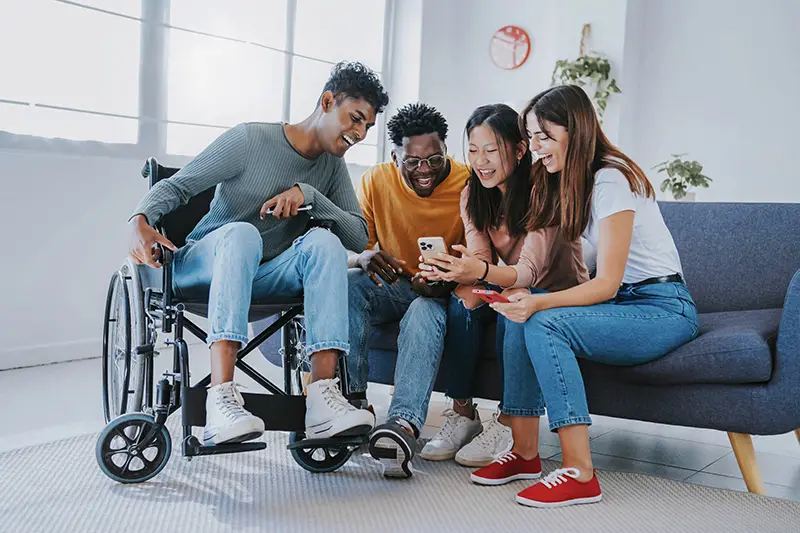In today's fast-paced, image-driven world, it's easy to feel overlooked. We're surrounded by ads filled with picture-perfect faces, flawless bodies, and airbrushed lives. The constant stream of "perfection" can make anyone feel insecure about how they look or who they are.
But as someone who has used a wheelchair his entire life, I want to feel seen when I watch an advertisement. I want to know that brands care about people like me and that they represent every type of consumer. No matter your situation or ability, representation matters.
Here are five important reasons why including wheelchair users in media is both the right thing to do and good for everyone.
1. Wheelchair users deserve to feel welcomed and seen
When brands showcase people who use wheelchairs, they send a clear message: you belong here, too. Seeing yourself represented builds trust and a sense of belonging.
No one wants to support a company or visit a destination that only highlights one type of person. Representation makes people feel valued, and that connection encourages wheelchair users to choose brands that make them feel seen over those that do not.
2. Inclusion shows your brand is for everyone
No business wants to limit its reach, and yet many do exactly that by not representing people with disabilities. Featuring wheelchair users tells your audience that your brand is open to everyone.

Every person in the world falls into one of two broad categories: they can either walk or they cannot, for any number of reasons. By showing both in your advertising, you include everyone and exclude no one. That simple choice can make your brand feel truly welcoming.
3. It builds a friendly and accepting image
A brand that features wheelchair users shows warmth, openness, and authenticity. It tells the world that your business doesn't just talk about inclusion, it practices it.
This type of representation builds emotional connection. When people of all abilities see themselves reflected in your content, they are more likely to trust your brand and support it. Inclusion is both the ethical choice and a smart business strategy.
4. It shows a true picture of society
Only showing able-bodied people in media gives a false impression of what our world looks like. People who use wheelchairs are not rare or separate from society. Some may have been born with disabilities, while others use a wheelchair temporarily due to injury, illness, or aging.
Think of the elderly, athletes recovering from sports injuries, or even someone who had a hiking accident. The public is make up of people with all kinds of abilities, and media should reflect that beautiful diversity. When it does, ads feel more relatable and real.
5. It can reach 80 million potential new customers
The World Health Organization estimates that about 80 million people worldwide use a wheelchair. That's 80 million potential customers with buying power. Ignoring wheelchair users in advertising means missing out on an enormous audience that wants to feel valued and included.
Brands that embrace inclusive marketing not only strengthen relationships and reputation, but also increase revenue. Inclusion benefits everyone, in every way.
There are countless reasons why representation matters, but here's the most important one: everyone deserves to feel noticed, appreciated, and accepted.
By including wheelchair users in mainstream media, we take one step closer to a more inclusive world where everyone can see themselves reflected. Representation empowers individuals, builds empathy, and helps shape a society that truly values equality and belonging for all.
About the author
After being diagnosed with Spinal Muscular Atrophy at the age of two, Cory Lee's thirst for adventure never ceased. He went on many trips around the U.S. when he was younger, and then started taking things internationally when he turned 15. Since then, Cory has traveled to 21 countries across six continents, all while managing to start up his travel blog Curb Free with Cory Lee, where he shares his accessible, and sometimes not-so-accessible travel adventures with others. Cory is a member of the Society of American Travel Writers (SATW) and the North American Travel Journalists Association (NATJA). He has been featured in the Los Angeles Times, USA Today, in a nationwide segment for CBS News, Lonely Planet, and many others. His blog won the 2017 Best Travel Blog Gold Lowell Thomas Award. He hopes to inspire other wheelchair users to roll out of their comfort zone and see all of the beauty that the world has to offer.
Cory Lee's ride is a QUICKIE Q500 M.
Most of the stories here on LiveQuickie.com were submitted by readers. Do you have a story to tell? We'd love to hear it. Submit your story here.